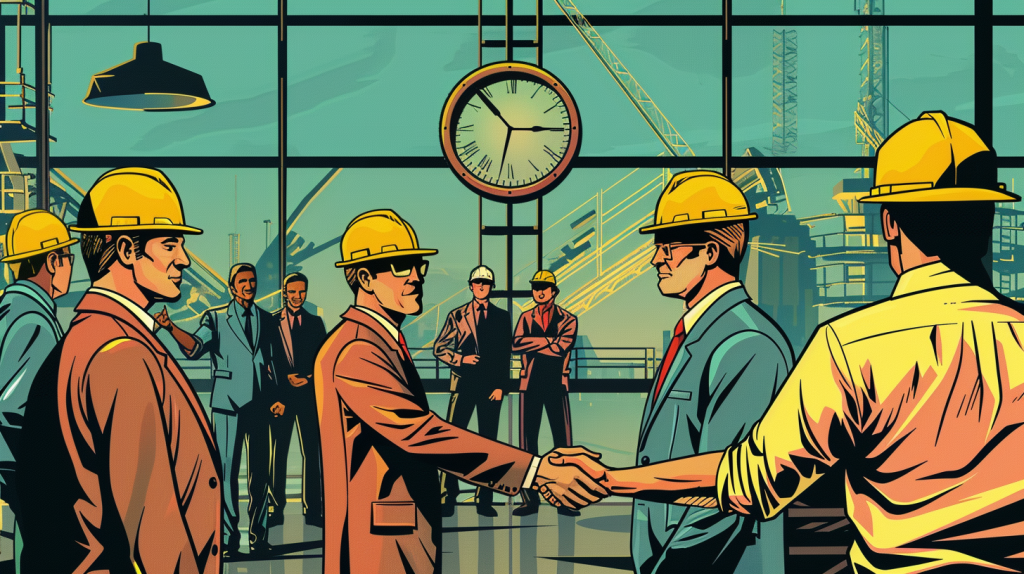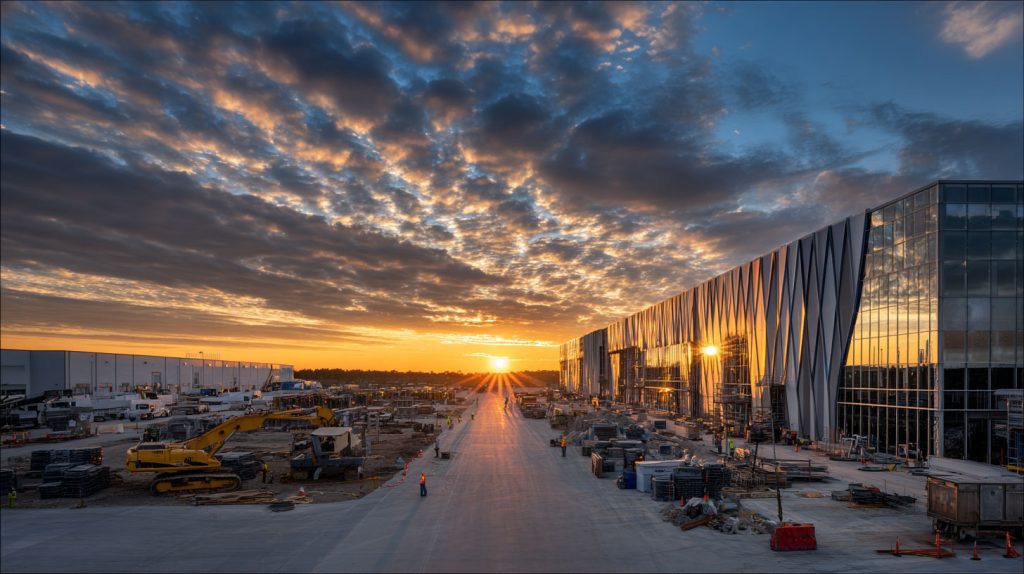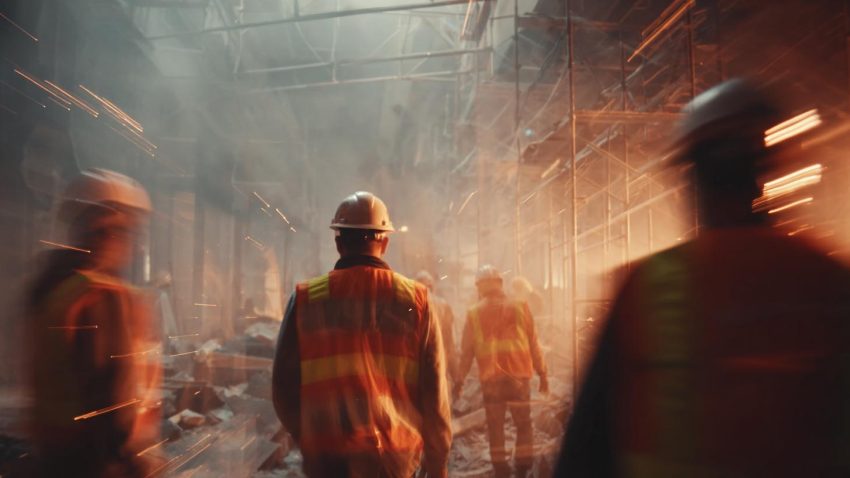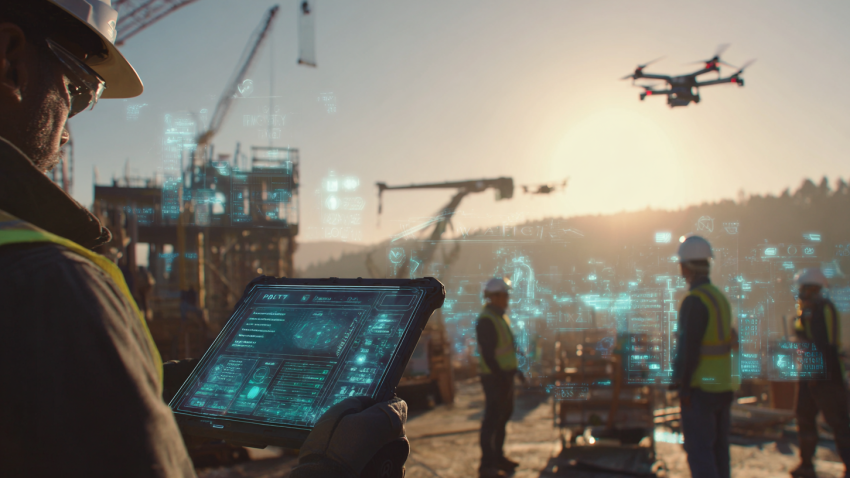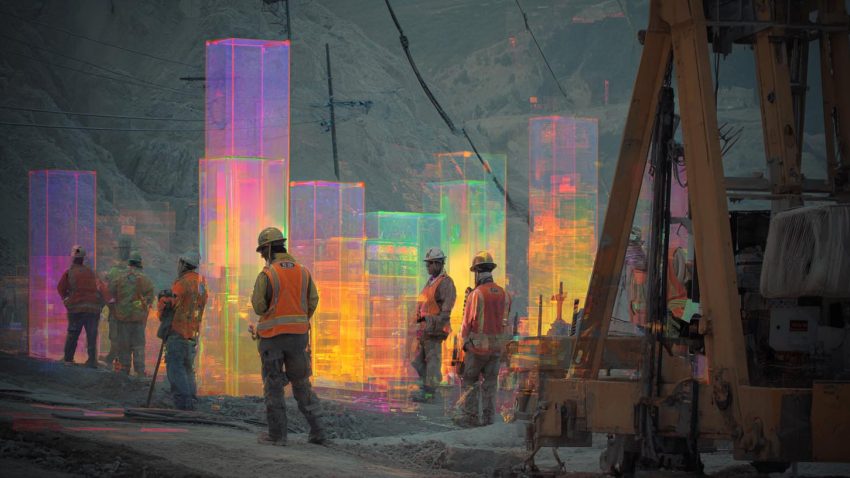Mission-Critical Construction: Managing Safety, Workforce, and Permitting Challenges in Hyperscale Data Center Construction
Table of Contents:
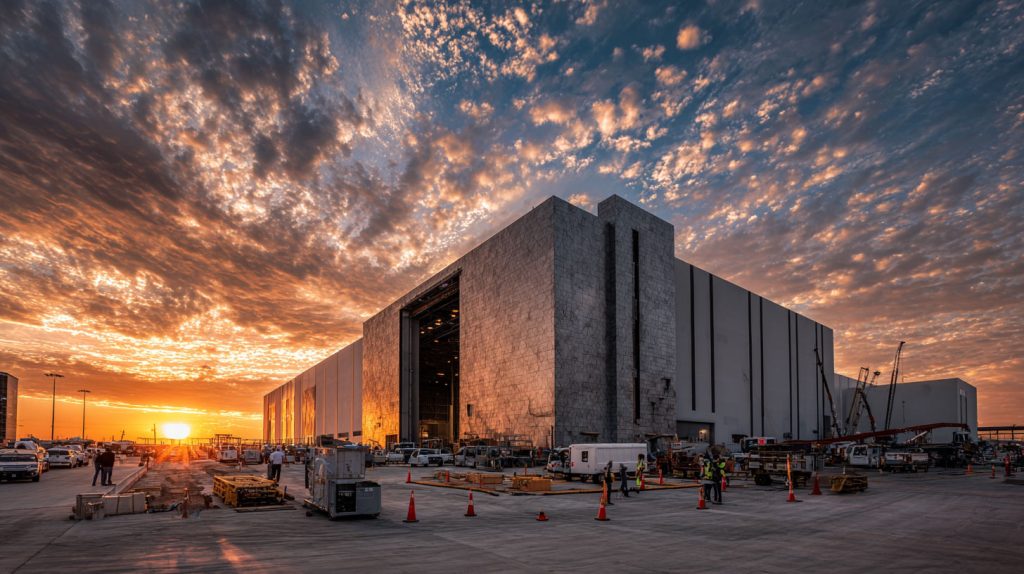
Building hyperscale data centers is a race against time, precision, and risk. These mission-critical facilities power global cloud networks, AI platforms, and financial systems that can’t afford a single second of downtime. As demand for capacity surges, contractors and superintendents face unprecedented challenges—not just in scheduling and logistics, but in safety management, workforce coordination, and permitting compliance.
Unlike typical commercial projects, hyperscale data centers run 24/7 during operation and are built under extreme pressure to meet go-live targets. Sites often host thousands of workers across multiple shifts, operating heavy equipment in confined areas. Coordinating safety, productivity, and compliance at that scale requires a mix of discipline, foresight, and technology.
Safety risks increase as labor demand grows. Tight schedules can push crews to work longer hours and across overlapping zones. Meanwhile, permitting and regulatory processes struggle to keep pace with project speed—forcing construction teams to balance speed with compliance.
Today, leading contractors are turning to digital platforms and AI-driven solutions to manage these complexities. From predictive safety analytics to digital permitting workflows, these technologies are helping superintendents maintain control over rapidly evolving sites.
In this article, we’ll explore how mission-critical construction leaders are managing the triple challenge of safety, workforce, and permitting in hyperscale data center builds—and how platforms like StruxHub are modernizing these systems for the next generation of construction.
Why Safety Is the Top Priority in Hyperscale Construction
Safety in hyperscale data center construction goes beyond regulatory compliance—it’s the foundation of productivity and reputation. With thousands of workers operating cranes, electrical systems, and heavy machinery, even a single oversight can lead to catastrophic consequences.
Superintendents must navigate a complex web of safety standards, including OSHA, NFPA, and owner-specific requirements. High-risk activities such as energized electrical work, confined space operations, and multi-level crane lifts demand continuous monitoring. In mission-critical construction, safety planning starts before mobilization and continues through commissioning.
Digital tools are now giving teams new ways to manage safety. AI-powered cameras, IoT sensors, and real-time dashboards detect unsafe behaviors, track PPE compliance, and alert supervisors instantly when risks appear. Proactive analytics allow safety managers to predict and prevent incidents before they occur.
Top Benefits
- Reduces accidents through real-time hazard detection and alerts.
- Improves safety compliance across large, multi-trade worksites.
- Strengthens workforce culture through transparency and accountability.
Best Practices
- Integrate AI-based safety monitoring and incident tracking.
- Conduct daily toolbox talks with digital safety data.
- Standardize reporting formats to ensure rapid communication.
Q&A Mini Section
Q: Why is safety harder to manage in hyperscale construction?
A: Because of the project’s massive scale, overlapping trades, and compressed timelines that increase human and equipment interactions.
Q: Can technology replace traditional safety supervision?
A: No—but it enhances visibility and enables faster response to high-risk situations.
Q: How does safety affect productivity?
A: A safe site is a productive site—fewer incidents mean fewer delays and disruptions.
Mission-critical contractors understand that safety isn’t a checkbox—it’s the first and most important performance metric.
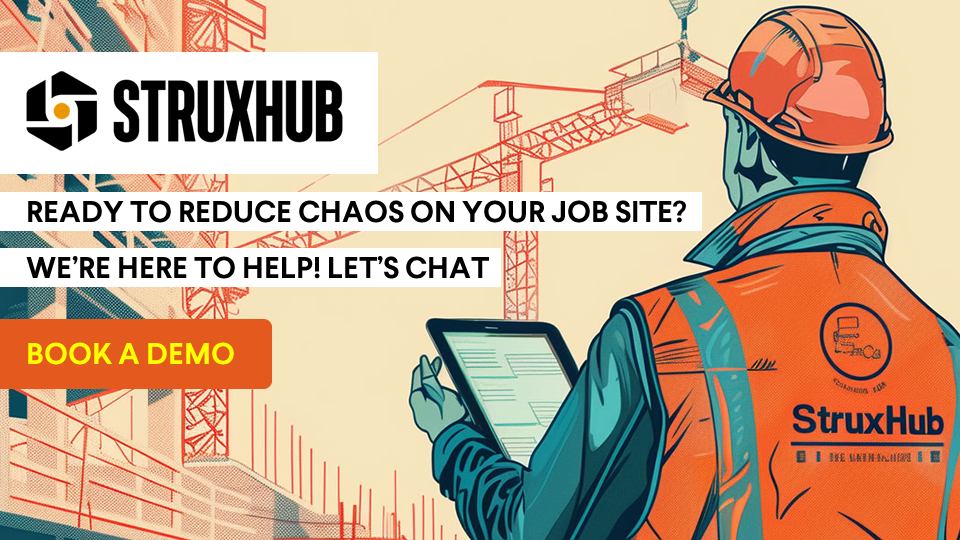
How Superintendents Manage Large, Multi-Shift Workforces
Workforce coordination is one of the biggest challenges in hyperscale data center construction. Projects can involve more than 1,500 workers on multiple shifts, with dozens of subcontractors operating simultaneously. Keeping everyone aligned, safe, and efficient requires strategic planning and real-time communication.
Superintendents must manage labor distribution, shift rotations, and crew assignments while monitoring productivity and safety performance. Labor shortages add another layer of difficulty—forcing teams to rely on workforce forecasting and training programs to fill critical roles.
Digital workforce management platforms now make this easier. AI systems track manpower by trade and skill level, helping superintendents balance workloads and anticipate shortages. Attendance tracking and geofencing ensure that only authorized personnel are onsite. Mobile dashboards give supervisors visibility into who’s working where and what tasks are complete.
Top Benefits
- Optimizes crew utilization and shift scheduling.
- Improves accountability through digital attendance and reporting.
- Reduces turnover and safety risks through transparent communication.
Best Practices
- Use digital workforce tracking tools integrated with project schedules.
- Provide ongoing training to maintain safety and technical standards.
- Review shift data weekly to identify labor imbalances.
Q&A Mini Section
Q: How does workforce tracking improve efficiency?
A: It ensures labor resources are assigned where they’re most needed and prevents duplication or idle time.
Q: What’s the biggest workforce challenge in hyperscale builds?
A: Retaining skilled labor and maintaining safety compliance under fast-track conditions.
Q: Can digital tools help with labor forecasting?
A: Yes—AI systems analyze schedule trends and skill requirements to predict future labor needs accurately.
A well-managed workforce isn’t just about numbers—it’s about coordination, communication, and care for the people powering the project.
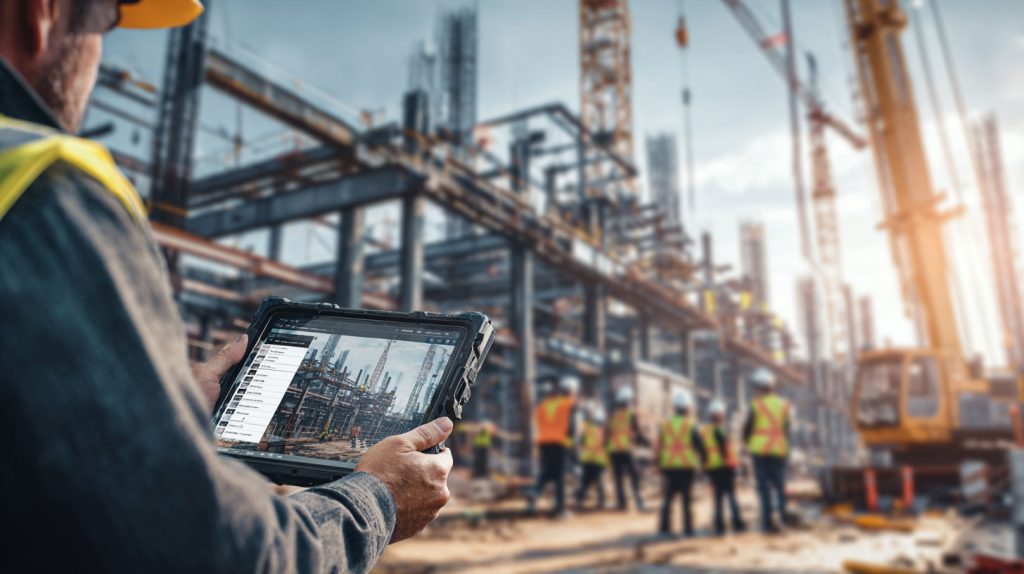
The Complexities of Permitting in Mission-Critical Construction
Permitting is often an underestimated challenge in hyperscale construction. While the industry races toward faster build times, regulatory agencies and utility providers operate at a much slower pace. Managing the flow of permits—zoning, electrical, mechanical, environmental, and occupancy—requires both patience and precision.
Superintendents and project managers must track hundreds of permits simultaneously, each with its own documentation, review cycles, and approval requirements. A single delayed permit can hold up an entire project phase, from foundation work to energization.
To stay ahead, contractors are embracing digital permitting systems. These tools centralize documentation, automate approval tracking, and provide live status updates to the project team. Some AI-enabled systems even predict approval timelines based on historical data, helping teams adjust schedules proactively.
Top Benefits
- Reduces permit delays through centralized digital tracking.
- Improves compliance and transparency with authorities.
- Helps align construction sequencing with permit readiness.
Best Practices
- Begin permit applications during preconstruction to avoid bottlenecks.
- Maintain a digital dashboard of all permits and approval statuses.
- Communicate regularly with local authorities and utility partners.
Q&A Mini Section
Q: Why do permit delays occur on hyperscale projects?
A: Because agencies can’t always match the accelerated timelines of hyperscale builds, especially for complex mechanical and electrical systems.
Q: How does digital permitting help?
A: It streamlines documentation and provides live visibility into approval timelines.
Q: What’s the superintendent’s role in permitting?
A: They coordinate with project managers and inspectors to ensure construction aligns with permit conditions.
Permitting might not make headlines, but it determines whether projects move—or stall. Proactive planning turns regulatory complexity into operational control.
Building a Strong Safety Culture on Mission-Critical Jobsites
A strong safety culture is the foundation of every successful mission-critical construction project. For hyperscale data centers—where thousands of workers operate around heavy equipment and energized systems—safety can’t rely on compliance alone. It must become part of the site’s daily mindset.
Superintendents play a key role in shaping that culture. They lead by example, enforcing procedures while fostering communication and trust. When workers feel empowered to report hazards or suggest improvements, safety becomes proactive rather than reactive.
Technology now reinforces this culture. AI-enabled safety platforms analyze patterns in incidents and near misses, helping teams predict high-risk activities before they occur. Mobile apps streamline toolbox talks, digital sign-ins, and field reporting. By turning safety into a shared, data-driven responsibility, teams can achieve record-breaking productivity without sacrificing well-being.
Top Benefits
- Fosters accountability and shared responsibility among workers.
- Reduces incidents through predictive analysis and real-time alerts.
- Strengthens communication between crews, supervisors, and safety officers.
Best Practices
- Conduct short, frequent safety huddles with digital check-ins.
- Encourage open communication about hazards without fear of blame.
- Use safety dashboards to celebrate milestones and share performance metrics.
Q&A Mini Section
Q: How can superintendents promote a safety-first mindset?
A: By modeling consistent behavior, rewarding safe practices, and making safety a visible part of daily planning.
Q: What’s the role of AI in safety culture?
A: It identifies patterns and predicts risks, allowing leadership to address potential issues before they cause incidents.
Q: Why is safety linked to morale?
A: Workers who feel protected and respected perform better and are more engaged in the project’s success.
In hyperscale construction, safety culture isn’t just a program—it’s the invisible structure holding everything together.
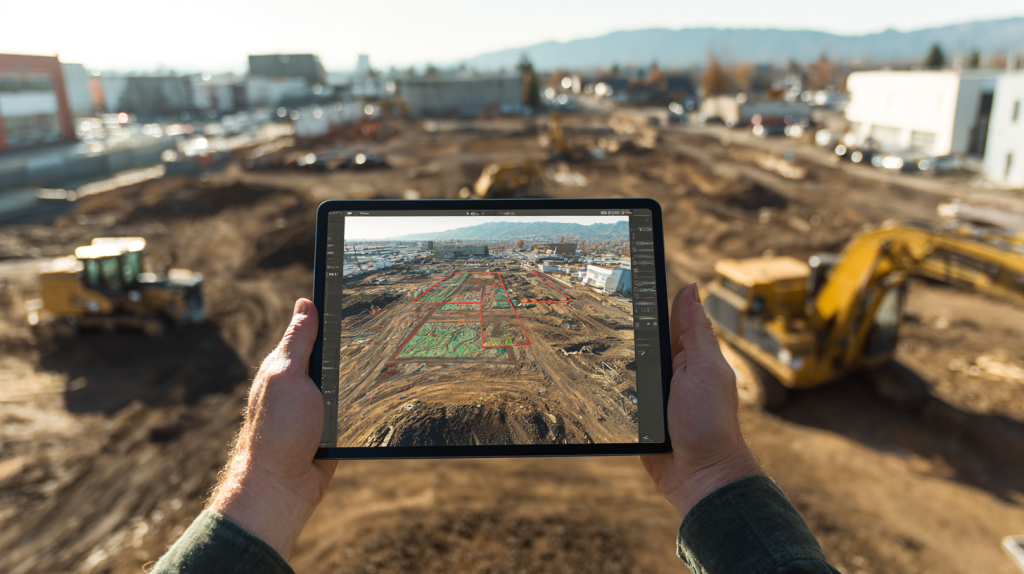
StruxHub
Experience the power of StruxHub today and witness firsthand how it can revolutionize your construction operations.
How Technology and Automation Are Simplifying Compliance and Reporting
Compliance in mission-critical projects involves hundreds of moving parts—permits, inspections, certifications, and safety records. Tracking all of this manually can be overwhelming, especially across multiple shifts and contractors. Automation and AI are now transforming compliance from an administrative burden into a streamlined, continuous process.
Digital compliance platforms centralize everything from safety documentation to environmental reports. Sensors and wearable devices feed live data on worker activity, equipment usage, and site conditions directly into the system. When non-compliance or anomalies occur, alerts are sent automatically.
AI enhances this process by recognizing patterns. For example, it can flag recurring inspection delays, missing PPE documentation, or equipment that’s overdue for testing. These proactive alerts help teams resolve compliance gaps before audits or inspections.
By turning compliance into an automated workflow, construction teams free up time for planning and coordination—reducing both stress and risk.
Top Benefits
- Simplifies compliance management through centralized automation.
- Reduces human error by standardizing documentation.
- Provides live audit trails for inspectors and owners.
Best Practices
- Use AI-enabled platforms for automated compliance reporting.
- Integrate safety, environmental, and workforce data into one dashboard.
- Schedule periodic digital audits to validate data accuracy.
Q&A Mini Section
Q: How does automation improve compliance accuracy?
A: It eliminates manual entry errors and ensures documentation is updated in real time.
Q: Can compliance data be shared with inspectors digitally?
A: Yes—cloud platforms allow secure, real-time access for auditing and verification.
Q: What’s the biggest compliance challenge on hyperscale projects?
A: Keeping documentation consistent across dozens of subcontractors and trades.
With automation, compliance shifts from reactive reporting to continuous verification—a major step forward for mission-critical construction.
Workforce Well-Being and Productivity in High-Pressure Environments
Hyperscale construction sites are high-pressure environments. Tight deadlines, overlapping trades, and 24/7 operations create intense physical and mental demands on workers. Balancing productivity with workforce well-being has become a top priority for modern superintendents.
AI and analytics now help monitor labor health and productivity in real time. Wearable devices track fatigue indicators, such as elevated heart rates or excessive shift lengths, prompting supervisors to intervene before exhaustion leads to accidents. Digital scheduling tools ensure that shifts remain balanced and rest periods are enforced.
Beyond monitoring, leadership culture plays a crucial role. When superintendents invest in worker well-being—through training, recognition, and safe working conditions—projects experience higher retention, fewer errors, and stronger morale. Technology amplifies these human-centered efforts by turning worker data into actionable insights.
Top Benefits
- Improves safety and performance through fatigue monitoring.
- Reduces turnover by promoting well-being and engagement.
- Increases productivity through balanced scheduling and workload tracking.
Best Practices
- Implement wearables for fatigue and health monitoring.
- Use AI workforce analytics to balance shift assignments.
- Encourage rest, hydration, and recognition programs to sustain morale.
Q&A Mini Section
Q: How does worker well-being impact project outcomes?
A: Healthy, motivated teams work more efficiently, produce higher-quality results, and experience fewer incidents.
Q: Can AI detect worker fatigue?
A: Yes—wearable devices and analytics track biometric data to flag early signs of overexertion.
Q: What’s the superintendent’s role in workforce well-being?
A: To lead with empathy, enforce fair schedules, and model a culture of respect and balance.
A thriving workforce is a productive workforce—and in mission-critical construction, both are essential for success.
How StruxHub Helps Contractors Manage Safety, Workforce, and Permitting
Managing safety, workforce logistics, and permitting at hyperscale is complex, but StruxHub simplifies it all in one unified platform. It gives superintendents and project managers real-time visibility into every jobsite activity, helping them stay compliant, safe, and productive without losing momentum.
With StruxHub, safety checklists, incident reports, and daily inspections are digitized and accessible from any device. Workforce management tools track attendance, certification compliance, and productivity metrics, while AI analytics identify trends that could affect safety or performance.
On the permitting side, StruxHub centralizes all approval workflows—linking documentation, inspection reports, and authority communications in one place. Teams can monitor permit statuses, receive automatic updates, and share reports instantly with inspectors and owners.
By merging safety, workforce, and permitting management into a single data-driven environment, StruxHub empowers teams to manage complexity with confidence. The result: safer sites, smoother permitting, and stronger workforce alignment.
Top Benefits
- Centralizes safety, workforce, and permit data into one platform.
- Provides predictive analytics to anticipate risks and labor shortages.
- Streamlines compliance and reporting through automation.
Best Practices
- Use StruxHub dashboards to monitor safety performance daily.
- Track permits and workforce certifications through the integrated platform.
- Review analytics weekly to identify and address recurring issues.
Q&A Mini Section
Q: How does StruxHub improve safety management?
A: It digitizes checklists, tracks incidents, and uses AI to identify high-risk trends before accidents occur.
Q: Can StruxHub manage both workforce and permitting workflows?
A: Yes—it connects scheduling, documentation, and compliance in one centralized system.
Q: Why is StruxHub ideal for hyperscale projects?
A: Because it scales seamlessly, handling thousands of workers, dozens of trades, and complex approval processes simultaneously.
With StruxHub, mission-critical contractors move from reactive management to predictive control—delivering safer, faster, and fully compliant data center projects.
Related Pillar Articles:
Best Guide to Construction Logistics Plans (CLPs): What Owners Want to See Before Work Starts
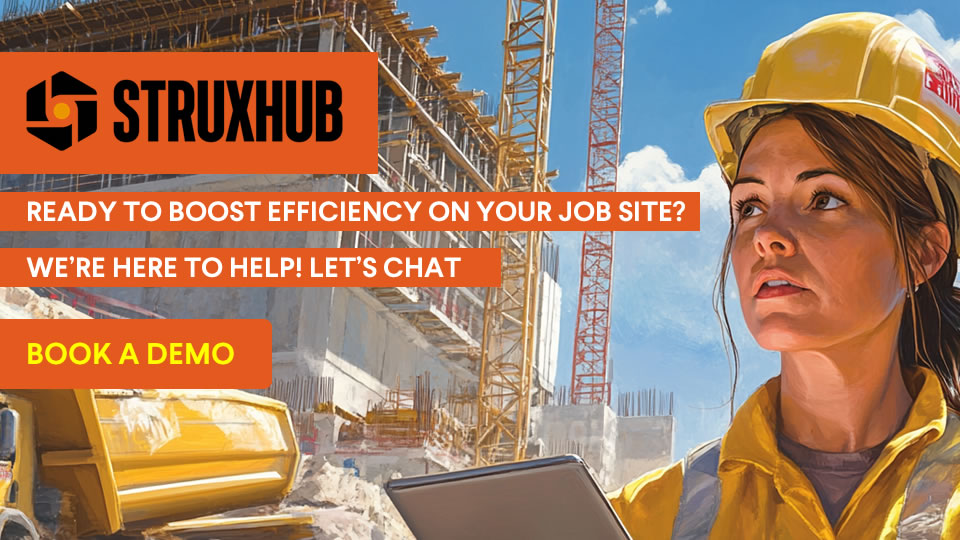
FAQ
Why is safety such a critical challenge in hyperscale data center construction?
Safety is one of the most complex challenges in hyperscale construction because of the sheer size, speed, and technical intensity of the projects. A hyperscale data center can host thousands of workers, dozens of cranes, and miles of cabling all operating simultaneously across multiple shifts. This density creates a high-risk environment where even minor lapses in communication or oversight can lead to major incidents.
Mission-critical sites also involve high-voltage electrical systems, heavy mechanical lifts, and complex crane coordination—all under tight schedules. Safety must therefore be deeply integrated into the project’s DNA. Superintendents and safety officers use advanced planning, daily huddles, and digital checklists to ensure every worker understands their responsibilities and current site hazards.
AI and IoT technologies are now improving safety outcomes. Wearables and cameras monitor PPE compliance and detect unsafe behavior in real time, while analytics predict high-risk activities based on previous incidents. This proactive approach prevents accidents before they occur.
In short, safety is more than compliance—it’s about protecting lives and productivity simultaneously. A strong safety program ensures that the project doesn’t just finish on time but finishes responsibly, maintaining both uptime for clients and well-being for workers.
How do superintendents coordinate and manage large workforces on hyperscale projects?
Coordinating a large, multi-shift workforce is one of the superintendent’s toughest jobs. A hyperscale build can involve thousands of workers from dozens of trades, all working in confined or overlapping spaces. The key to managing this complexity lies in structure, visibility, and communication.
Superintendents rely on workforce management platforms that track attendance, skills, and shift assignments in real time. Digital tools like StruxHub integrate this data with schedules and logistics, allowing leaders to monitor manpower across all trades. This visibility helps balance workloads, prevent overstaffing, and ensure that the right people are in the right place at the right time.
AI-powered analytics now assist in forecasting labor needs, detecting inefficiencies, and predicting fatigue risk. When paired with transparent communication—daily briefings, mobile updates, and live dashboards—these tools create a synchronized rhythm across massive teams.
Ultimately, effective workforce coordination is about balance: meeting aggressive timelines without burning out crews. Superintendents who master this balance maintain safety, morale, and productivity across even the most demanding data center projects.
StruxHub
Discover how StruxHub can revolutionize your construction management. Contact us today!
What makes permitting so difficult for mission-critical construction projects?
Permitting in hyperscale construction is difficult because the projects move faster than traditional approval systems. Local governments, environmental regulators, and utility providers often operate on timelines that can’t match the rapid pace of mission-critical development.
Data centers also have unique permitting challenges. They require specialized electrical, mechanical, and environmental approvals due to their high energy use and complex cooling systems. Each permit involves its own documentation, inspections, and conditions, which can number in the hundreds.
Superintendents and project managers manage this maze by adopting digital permitting tools that centralize documentation and automate tracking. These systems send alerts for upcoming expirations, missing paperwork, or delayed responses. Some AI-based solutions even estimate approval timelines based on historical data.
Maintaining open communication with permitting agencies is essential. Regular progress updates, pre-inspection meetings, and digital transparency help build trust and minimize review time.
By combining proactive planning with digital workflows, contractors can keep permitting from becoming a bottleneck—ensuring that regulatory compliance keeps pace with the speed of mission-critical construction.
How can technology improve safety, workforce, and permitting management simultaneously?
Modern construction technology connects previously separate workflows—safety management, workforce tracking, and permitting—into one digital ecosystem. AI, IoT sensors, and cloud-based software make it possible to monitor all three areas in real time, improving visibility and control across the jobsite.
For safety, AI-enabled cameras and wearable devices detect hazards automatically, while predictive analytics highlight high-risk patterns before incidents occur. Workforce management systems track attendance, skill levels, and certifications, ensuring every worker meets site requirements. Meanwhile, permitting software centralizes documents, automates reminders, and keeps all teams informed of approval statuses.
When integrated, these systems share data seamlessly. For example, if a new worker joins the project, their credentials automatically link to safety compliance records and permit access zones. This creates a continuous feedback loop that keeps the site secure, compliant, and efficient.
Platforms like StruxHub unify these functions in one interface, allowing superintendents to oversee safety, labor, and permits without juggling multiple systems. The result is a jobsite that’s not only more productive but also more predictable and transparent.
How does StruxHub help contractors handle safety, workforce, and permitting challenges?
StruxHub simplifies the complexity of hyperscale data center construction by centralizing three core challenges—safety, workforce coordination, and permitting—in a single intelligent platform.
For safety, StruxHub digitizes inspections, checklists, and incident reporting. AI analytics detect risk trends, helping teams prevent accidents before they occur. For workforce management, the platform tracks manpower by trade, shift, and certification status in real time, giving superintendents a complete view of onsite personnel.
On the permitting side, StruxHub provides a live dashboard where all approvals, documents, and inspection statuses are stored and updated automatically. This visibility ensures compliance and keeps the project moving without delays.
What sets StruxHub apart is its ability to connect these workflows. A single update—like a new worker or inspection—automatically synchronizes across safety, workforce, and permitting modules. This integration eliminates data silos, improves communication, and provides superintendents with total control of project operations.
By turning complex project management into an intuitive, data-driven process, StruxHub helps contractors deliver hyperscale data centers faster, safer, and fully compliant with every regulation.
